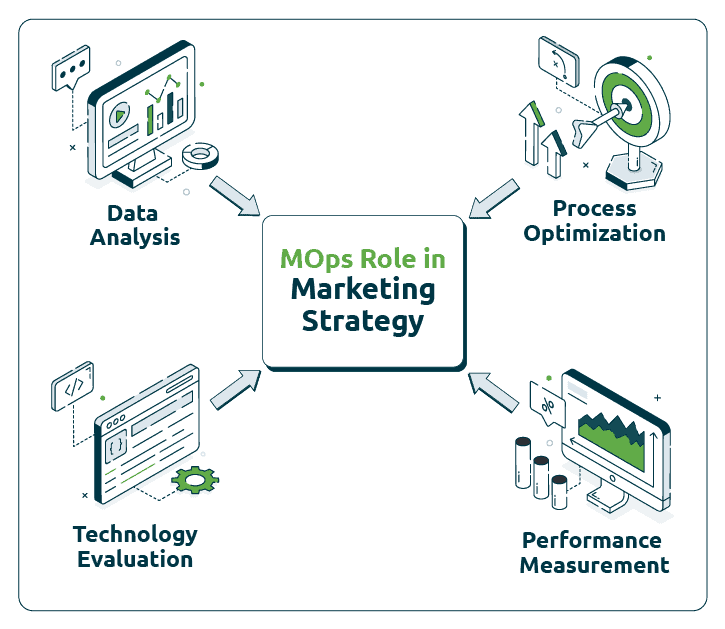There’s been no shortage of emphasis on the gaping misalignment between sales and marketing over the last few years. Of course the two departments must work in cohesion, but what about marketing itself? Many organizations have been struggling with an even more problematic disconnect that hasn’t gotten the same air time: the disconnect between marketing leadership (e.g. the CMO) and marketing operations (MOps). Here’s a closer look at why this is so prevalent, why it has to stop, and how to do so.
The Problem, as Usual, Lies in the Silos
While everyone has been busy worrying about getting sales and marketing in cahoots, marketing misalignment has taken root. In many B2B organizations, the scenario goes something like this. The CMO sets a strategic vision and then tells MOps to execute on it. Sounds simple enough, right? In theory, maybe, but it’s a broken system.
For one, CMOs are generally skilled in strategy while MOps practitioners are skilled in execution. When a CMO is solely responsible for the strategic direction of a company, they’re using their strategic lens without understanding what it takes on a tactical level to bring such ideas to life.

This is particularly true when it comes to technology. As an example, the CMO might understand, in broad strokes, what an account-based marketing (ABM) platform can do. But they might not know that the ABM strategy they set is not only impractical, but actually bordering on impossible, with the system they have in place.
Does MOps push back, and demand a new strategy? Usually, no. Instead, they typically end up forcing the strategy to fit their tools – and the strategy becomes something entirely different than intended. It’s not that surprising, then, that 70-80% of MOps professionals surveyed stated that the original strategy they’re given by a CMO is not the one that actually gets implemented.
How often does the implemented solution match the original vison/strategy that was provided?
The Effects of Misalignment
So, why does the strategy change so much from the time the CMO hands it over to MOps? For one, it’s almost always too high-level. An example might be “to increase our bottom line revenue.” That’s far too broad to be executed against.
Furthermore, it’s created without taking into account crucial pieces of the execution like the company’s tech stack, target audience criteria, activity, engagement and so forth. The strategy ends up being something general to be applied across the board rather than being refined according to these aforementioned factors.
Such top-down strategies also often miss the mark of people, process and technology. The timings are not agreed upon, nor set in the context of buyers’ buying cycles, and the understanding of tech capabilities is often missing. For example, a CMO might want to use omnichannel marketing, without knowing whether their specific marketing automation tool can actually handle the scope of what they have in mind.
The main point, though, is that marketing strategies are designed to increase overall revenue, which means increasing opportunities and closed/won opportunities. But without being aligned to buying time frames, purchase cycles, buyer preferences and their specific tech stack, they might generate brand awareness – but won’t increase revenue as they hope to.
The Strategy / Execution Gap:
Marketing strategies are designed to increase overall revenue. But without being aligned to buying time frames, purchase cycles, buyer preferences and their specific tech stack, they won’t increase revenue as they hope to.
The Ideal Marketing to Marketing Relationships
None of this is intended to lay blame at the feet of the CMO. After all, siloed departments often occur as a result of structural and organizational issues within the company. For example, if marketing operations is housed in a different department or under a different leader than the rest of the marketing team, it can be more difficult to create a cohesive and integrated marketing strategy.
However organizations got to a point of misalignment isn’t what’s important, though. What’s important is where they can go from here. And the solution is actually quite simple. CMOs don’t need MOps to be experts in brand strategy. MOps doesn’t need the CMO to be well-versed in tactical execution. Instead, both teams need to work together to align during the creation of the marketing strategy before it gets set in stone.

Rather than the strategy being a top-down dictum, MOps should play a critical role in supporting its development. The expertise and insights of the department can help to ensure that the marketing strategy is grounded in data and aligned with the overall business objectives. Even more specifically, MOps can contribute to the development of the marketing strategy in a number of ways, including:
- Data Analysis: MOps can be responsible for collecting, analyzing and interpreting data related to customer behavior, market trends and campaign performance. This data can be used to inform the development of the marketing strategy.
- Process Optimization: The MOps team can help to streamline and optimize marketing processes, making it easier to execute on the strategy. By identifying and eliminating bottlenecks or inefficiencies, they can ensure the marketing strategy is executed efficiently and effectively.
- Technology Evaluation: MOps can help to evaluate and select the technology and tools that are needed to support the marketing strategy. By understanding the capabilities and limitations of different marketing technologies, they can guide the CMO as to whether a given marketing strategy is supported by the organization’s existing tools.
- Performance Measurement: MOps teams are responsible for measuring and analyzing the performance of marketing campaigns, channels and programs. This data can be used to evaluate the effectiveness of the marketing strategy, identify areas for improvement and inform future decision-making.
To perhaps overly simplify, solving this common misalignment and all the issues that it causes comes down to one thing: getting the CMO and MOps team in a room together to collaborate on the marketing strategy. This is the single best way to ensure the right strategy gets executed this year, and that you’re set up to optimize your results. Yes, sales and marketing must be aligned for B2B success. But marketing and marketing must be, too.














